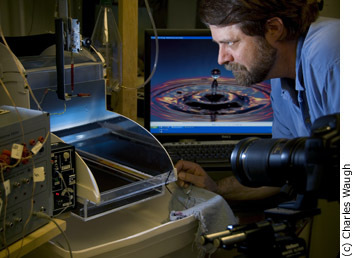|
All content (c) 2024, Martin Waugh
"Liquid Sculpture" is a registered trademark |
About the ProcessMartin Waugh is often asked about the technical process of creating this Liquid Sculpture images. In his words: What you see on this site are high-resolution photographs of liquids in motion, captured with high-speed flash photography. I use Photoshop to clean up the background, balance the color and tidy up a bit. I don't alter the shapes or composition. What you see is what nature provided. (One exception: the lips in "Big Wet One Red" were crying for red lipstick, which Photoshop provided.) The first high-speed photograph was taken around 1851, by William Talbot. He used an electric spark to stop motion, as did A. M. Worthington when he created the images for his 1908 book, A Study of Splashes. However, the discipline didn't truly expand until the 1930s when Dr. Harold Edgerton of M.I.T. invented the xenon flash tube, and amazed the world with previously unseen sights. His work remains the basis of all modern photographic flashes. The photographic challenges in my work were mostly solved by these pioneers, and by the advent of the computer. Now my main effort is orchestrating the lights and liquids to create the colors and shapes. The same characteristics of liquids that make them so visually engaging, also make them difficult to control. Therein lie the irresistible puzzle and satisfying rewards. More detailed information can be found on my personal blog, www.martin-waugh.com. And these two clips may be informative: High-speed video of drop-splash collisions on Time Warp and an interview for Discovery Channel Canada. Water Drop Photography ResourcesA very good "how-to" source is Loren Winter's site hiviz.com site. Make magazine offers a kit that looks like it would be a reasonable choice, too (I have no experience with it). See www.makezine.com/flashkit/. Martin Waugh
|
||
